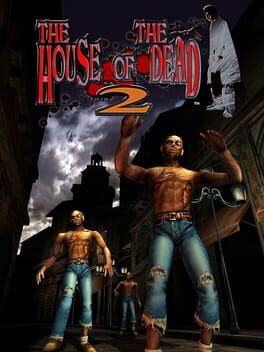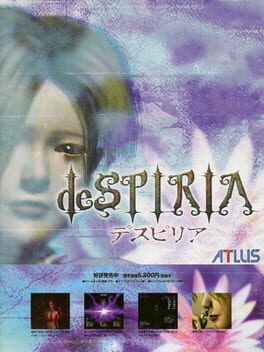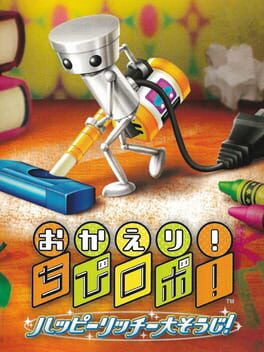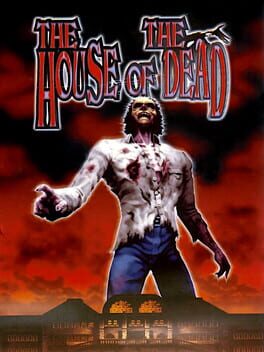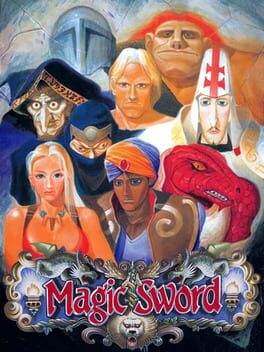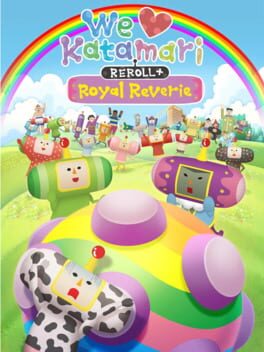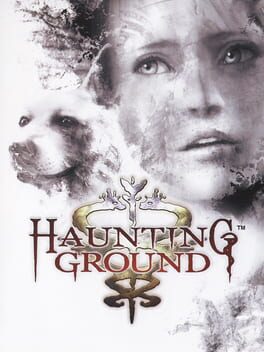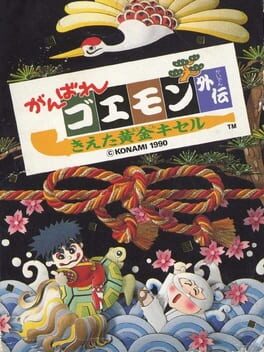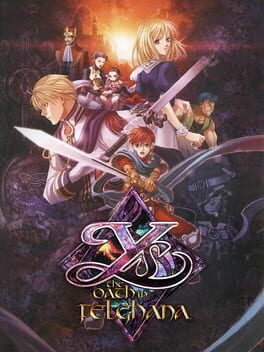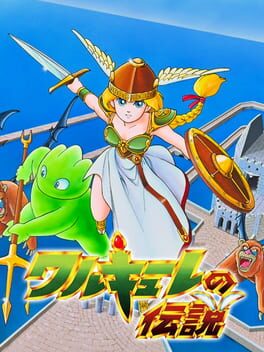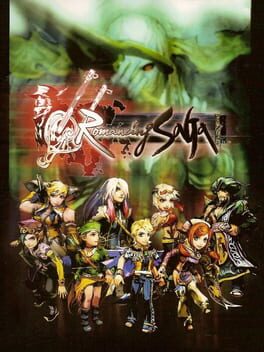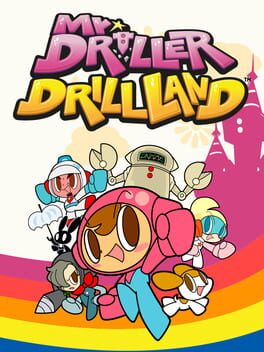hazys
597 Reviews liked by hazys
Look, I'll keep it real: I don't think it gets better than this. Playing this at an arcade is sublime, playing it at home is sublime. There is not a bad time to be playing House Of The Dead 2. Play it at Grandma's house, who gives a fuck!
I don't want to say that House Of The Dead 2 improves on its predecessor in every meaningful way, as I think both are functionally perfect at what they are setting out to do. It feels being needlessly nitpicky to try and denigrate one versus the other. I will say though that going from a fantastic gothic mansion to a beautifully rendered gothic European city is what gives this series that extra bit of spice. The locales are just incredible looking, the unnamed city clearly being Venice, Italy with a thick layer of grime applied to it. It's a visually very striking game, one of the earliest games I remember seeing and it absolutely struck a chord with me.
The monster designs are still the same level of high detailed grotesqueness that HotD1 showcased. I gotta say though, they outdid themselves with some of these guys. The "Bob" zombies who appear to have an executioner's hood stitched to their necks. The "Patrick" zombies in military fatigues with a pained look on their face. My absolute favorite, the "Ken" variant of the Kaegos, with a sick metal mask and pair of claws. Sega's ability to design the most entertaining group of guys to blow apart limb from limb is some auteur shit. This is an art game just by how cool all these fucking dudes are. The way they challenge the player's aiming is also more dynamic this time around. Randys hop around madly and can move from each side of the screen in an instant, Gregory uses a giant sword that can block your shots, requiring you to carefully hit him during openings. Gregory specifically comes before a boss based around that exact strategy! Cool stuff! There is also a greater variety of enemies who throw stuff at you, often in pairs, so you have to juggle priorities while shooting. For a game that by its very nature doesn't have a lot of depth, enemy design is absolutely trying to test the player as much as it can.
The violence in this bad boy is pretty graphic though. Was this a problem back in the day? This was such an established arcade cabinet to me I never thought about how gruesome it was. I can imagine someone's mom turning pale and fainting at the sight of the legendary Booger Monster as my friends and I christened him.
Bosses are a pretty vast upgrade across the board without question. There are more of them and they are actually challenging this time. I was going to go into depth about them, but I think they are all pretty much perfect. The way their weakspots aren't always visible means you no longer have total pushovers like Chariot was in the first game. Hierophant's chest flaps means you have to actually time your shots and can't just unload on him. Strength has very slim windows you can get a shot in on his head, and he scared the SHIT out of me as a kid because of that. The Magician, my beloved, returns, because honestly when you have a boss with THAT design and THAT banging theme, you really ought to bring him back. I'm glad they did! He rocks! The final boss, the Emperor, is actually a bit underwhelming in comparison to everyone else. He isn't quite as visually stunning, his theme is pretty average in comparison, but his pre-fight speech about hating mankind is pretty fucking awesome. Classic House of the Dead shit. The boss fights being framed with G's Files showing the weakpoints against taped pictures is another great aesthetic choice for a series that lives and dies on its visual flair.
I also think the rescues require more dynamic actions from the player. Remember, I'm using dynamic VERY lightly, as the main actions you take in this game are "shooting" and "not shooting." But a lot of the survivors will be positioned just awkwardly enough you'll have to place your shots carefully, or use trigger discipline that they don't get clipped by your shots. The amount this game requires you to carefully not shoot civilians, you have to imagine this is banned in every police academy in the country.
I should talk about the voice acting, actually. I'm gonna be honest, it might be that I have heard it so much in my life that I can recite it word-for-word, but I think it's mostly just funny bad. I don't think it's ASTONISHINGLY bad like Resident Evil 1. That game didn't sound like it was recorded by physical humans. I can tell actual people voiced James and Gary, very funny people, but people nonetheless. I don't know, it's still entertaining! But you be the judge.
Which is easy to do since you can actually play this pretty easily! It's on the dreamcast, PC, xbox with HOTD3 and wii, and while none of those versions are exactly READILY available, it's still a vast improvement over HotD1 only being playable via a putrid remake that looks like a 2010 shooter. Realistically, there should be a law that this has to be in every arcade or else it's not a legitimate business, but until then, play it anyway you can! It's fun! Play it with friends!
I don't want to say that House Of The Dead 2 improves on its predecessor in every meaningful way, as I think both are functionally perfect at what they are setting out to do. It feels being needlessly nitpicky to try and denigrate one versus the other. I will say though that going from a fantastic gothic mansion to a beautifully rendered gothic European city is what gives this series that extra bit of spice. The locales are just incredible looking, the unnamed city clearly being Venice, Italy with a thick layer of grime applied to it. It's a visually very striking game, one of the earliest games I remember seeing and it absolutely struck a chord with me.
The monster designs are still the same level of high detailed grotesqueness that HotD1 showcased. I gotta say though, they outdid themselves with some of these guys. The "Bob" zombies who appear to have an executioner's hood stitched to their necks. The "Patrick" zombies in military fatigues with a pained look on their face. My absolute favorite, the "Ken" variant of the Kaegos, with a sick metal mask and pair of claws. Sega's ability to design the most entertaining group of guys to blow apart limb from limb is some auteur shit. This is an art game just by how cool all these fucking dudes are. The way they challenge the player's aiming is also more dynamic this time around. Randys hop around madly and can move from each side of the screen in an instant, Gregory uses a giant sword that can block your shots, requiring you to carefully hit him during openings. Gregory specifically comes before a boss based around that exact strategy! Cool stuff! There is also a greater variety of enemies who throw stuff at you, often in pairs, so you have to juggle priorities while shooting. For a game that by its very nature doesn't have a lot of depth, enemy design is absolutely trying to test the player as much as it can.
The violence in this bad boy is pretty graphic though. Was this a problem back in the day? This was such an established arcade cabinet to me I never thought about how gruesome it was. I can imagine someone's mom turning pale and fainting at the sight of the legendary Booger Monster as my friends and I christened him.
Bosses are a pretty vast upgrade across the board without question. There are more of them and they are actually challenging this time. I was going to go into depth about them, but I think they are all pretty much perfect. The way their weakspots aren't always visible means you no longer have total pushovers like Chariot was in the first game. Hierophant's chest flaps means you have to actually time your shots and can't just unload on him. Strength has very slim windows you can get a shot in on his head, and he scared the SHIT out of me as a kid because of that. The Magician, my beloved, returns, because honestly when you have a boss with THAT design and THAT banging theme, you really ought to bring him back. I'm glad they did! He rocks! The final boss, the Emperor, is actually a bit underwhelming in comparison to everyone else. He isn't quite as visually stunning, his theme is pretty average in comparison, but his pre-fight speech about hating mankind is pretty fucking awesome. Classic House of the Dead shit. The boss fights being framed with G's Files showing the weakpoints against taped pictures is another great aesthetic choice for a series that lives and dies on its visual flair.
I also think the rescues require more dynamic actions from the player. Remember, I'm using dynamic VERY lightly, as the main actions you take in this game are "shooting" and "not shooting." But a lot of the survivors will be positioned just awkwardly enough you'll have to place your shots carefully, or use trigger discipline that they don't get clipped by your shots. The amount this game requires you to carefully not shoot civilians, you have to imagine this is banned in every police academy in the country.
I should talk about the voice acting, actually. I'm gonna be honest, it might be that I have heard it so much in my life that I can recite it word-for-word, but I think it's mostly just funny bad. I don't think it's ASTONISHINGLY bad like Resident Evil 1. That game didn't sound like it was recorded by physical humans. I can tell actual people voiced James and Gary, very funny people, but people nonetheless. I don't know, it's still entertaining! But you be the judge.
Which is easy to do since you can actually play this pretty easily! It's on the dreamcast, PC, xbox with HOTD3 and wii, and while none of those versions are exactly READILY available, it's still a vast improvement over HotD1 only being playable via a putrid remake that looks like a 2010 shooter. Realistically, there should be a law that this has to be in every arcade or else it's not a legitimate business, but until then, play it anyway you can! It's fun! Play it with friends!
deSpiria
2000
game has vibes for days. mainly due to the world created here with some help from a very cool dark ambient soundtrack. borderline visual novel with some gorgeous prerendered graphics. first person with adventure and rpg elements. you're an agent for the Church and you can read minds and have "mind battles." i can see why it was never localized (too much text and religious aspects and overall very obtuse).
Here's one I completed last year, but still lingers in my mind and asks me to replay it (which I will).
Extremely charming, silly, and emotionally affecting game about helping an impoverished family with more than just cleaning.
It's hard to believe it's on the DS. Graphically, along with Park Patrol (which I'm in the middle of playing), it is a technical marvel, with Chibi running around in full 3D environments, which are surprisingly expansive.
If you liked the original, I beg you to play this. Heck, I think this game is worth anyone's time.
(My save file, last I checked, was around 15 hours and 20 minutes)
Extremely charming, silly, and emotionally affecting game about helping an impoverished family with more than just cleaning.
It's hard to believe it's on the DS. Graphically, along with Park Patrol (which I'm in the middle of playing), it is a technical marvel, with Chibi running around in full 3D environments, which are surprisingly expansive.
If you liked the original, I beg you to play this. Heck, I think this game is worth anyone's time.
(My save file, last I checked, was around 15 hours and 20 minutes)
The fact this isn't a mainstay in every arcade in America is proof that this country is full of fucking shit.
Borderline perfect. The amount of style on display with this game feels a little underappreciated. The iconic voice bellowing "THE HOUSE...OF THE DEAD" over Dracula's Castle organ music. The incredibly varied and inspired monster designs, all moving and animating just beautifully, dismembering in ways that surely had to have blown your fucking mind in 1996. The way every sound-effect is perfected, from the gunshot to headshot to "RE-RE-RELOAD!" I have to blame preservation as to why this game is not a stone-cold classic like House Of The Dead 2 rightfully is.
Playing this thing is such a fucking hassle that I can understand why you might not even bother. The Saturn version is a very watered-down version, having to push a LOT of polygons on the ill-equipped Saturn. The PC version is a headache to get running in any year after 2007. The remake is...oooouuugh the fucking remake.
Your best option to play this beautiful little game is to get it running on MAME, which is tricky since MAME is a total pain in the fucking ass to get working and nobody is going to care enough to do it.
So, let's say you get ALL OF THAT up and running, and you are finally able to play The House...of the Dead.
It's a 30 minute long rail shooter.
This is why it needs to be back in physical arcades!! The experience is neutered by the headache required to play it along with the fact it is such a short game by design. If I ever got rich, I guarantee you my first wasteful rich guy purchase is a cabinet of House Of The Dead and inviting everyone over to play it.
It's just a tragedy that the hideous remake is now people's image of the game, with just some of the most ghastly visuals I've ever seen. The original has such a great color palette, it looks a very distinct way, very sharp and direct. It's impossible to replicate with modern day slop graphics.
I also think we need to appreciate the Magician more. That might be one of the best monster designs I've ever seen. He looks noble and elegant yet beastly. He stands dignified and it is absolutely believable he would be some mad genius's crowning jewel.
I think this game is stellar. The music is more brilliance from Sega's music department and creates the perfect symphony for one of the best light-gun games ever made. It's just a shame you can't play it in its original form in any way that is convenient.
Borderline perfect. The amount of style on display with this game feels a little underappreciated. The iconic voice bellowing "THE HOUSE...OF THE DEAD" over Dracula's Castle organ music. The incredibly varied and inspired monster designs, all moving and animating just beautifully, dismembering in ways that surely had to have blown your fucking mind in 1996. The way every sound-effect is perfected, from the gunshot to headshot to "RE-RE-RELOAD!" I have to blame preservation as to why this game is not a stone-cold classic like House Of The Dead 2 rightfully is.
Playing this thing is such a fucking hassle that I can understand why you might not even bother. The Saturn version is a very watered-down version, having to push a LOT of polygons on the ill-equipped Saturn. The PC version is a headache to get running in any year after 2007. The remake is...oooouuugh the fucking remake.
Your best option to play this beautiful little game is to get it running on MAME, which is tricky since MAME is a total pain in the fucking ass to get working and nobody is going to care enough to do it.
So, let's say you get ALL OF THAT up and running, and you are finally able to play The House...of the Dead.
It's a 30 minute long rail shooter.
This is why it needs to be back in physical arcades!! The experience is neutered by the headache required to play it along with the fact it is such a short game by design. If I ever got rich, I guarantee you my first wasteful rich guy purchase is a cabinet of House Of The Dead and inviting everyone over to play it.
It's just a tragedy that the hideous remake is now people's image of the game, with just some of the most ghastly visuals I've ever seen. The original has such a great color palette, it looks a very distinct way, very sharp and direct. It's impossible to replicate with modern day slop graphics.
I also think we need to appreciate the Magician more. That might be one of the best monster designs I've ever seen. He looks noble and elegant yet beastly. He stands dignified and it is absolutely believable he would be some mad genius's crowning jewel.
I think this game is stellar. The music is more brilliance from Sega's music department and creates the perfect symphony for one of the best light-gun games ever made. It's just a shame you can't play it in its original form in any way that is convenient.
Magic Sword
1990
Casting off the shroud of early CRPG aesthetics and, to a lesser extent, systems design, The Drowned City reveals the end to which the series has been working, its impoverished masterpiece: an ATLUS dungeon crawler. If it were only that it could perhaps be forgiven as a mediocrity, but what damns it is the way it still cleaves to that original Wizardraic form, in spite of having abandoned its fundamental goals.
The Drowned City seems to view the resource conversation which characterized the series' former entries as a flaw to be optimized out, and offers the player, from the start of the game, both inexpensive ways of recovering from death and TP depletion as well a frequency of shortcuts that makes getting back to any given spot from town almost effortless. This isn't a flaw in and of itself, of course: even Final Fantasy XIII, the best JRPG of all time, takes a similarly resource-agnostic approach. But while that game and its sequels had a variety of encounters which could approached systematically, each like a puzzle, The Drowned City's non-boss encounters are nowhere near diverse or complex enough to be compelling when they have no long-term bearing on one's progress.
Where The Drowned City's genericization is most apparent, however, is in that aspect which is the most superficially original: its characters and narrative framing. Where Heroes of Lagaard's townspeople were generic town-NPC archetypes whose nuances became apparent over the course of the game, The Drowned City's simply reiterate their one quality, the quirk that is expected to sustain them through the next fifty hours. By the end of the former game, the shopgirl was like a friend's daughter who I sometimes watch on weekends; the latter game's characters never really grew on me. This is particularly damaging to the plot, which is both considerably more present in this entry and driven by characters who are ultimately pretty dull.
What decisively renders this the weakest of the DS Etrian games, though, is the design of its strata, of which only the fifth stands out aesthetically. The third stratum, in particular, is the most visually and aurally generic in series thus far, and has the gall to be the longest in the game. More than their individual failings, however, what hurts this labyrinth is its lack of aesthetic unity: it feels as if it's comprised of six unrelated dungeons and dispenses with former entries' sense of progression.
The Drowned City retains a great deal of what's good about the series: its character and monster design, the Yuzo Koshiro soundtrack, and puzzle design which admittedly blossoms in this game. Its class portraits felt somewhat overdesigned and specific for blank-slate characters, but are nevertheless good on their own terms. Olympia was the standout cast member but she deserved to go a little more sicko I think.
The Drowned City seems to view the resource conversation which characterized the series' former entries as a flaw to be optimized out, and offers the player, from the start of the game, both inexpensive ways of recovering from death and TP depletion as well a frequency of shortcuts that makes getting back to any given spot from town almost effortless. This isn't a flaw in and of itself, of course: even Final Fantasy XIII, the best JRPG of all time, takes a similarly resource-agnostic approach. But while that game and its sequels had a variety of encounters which could approached systematically, each like a puzzle, The Drowned City's non-boss encounters are nowhere near diverse or complex enough to be compelling when they have no long-term bearing on one's progress.
Where The Drowned City's genericization is most apparent, however, is in that aspect which is the most superficially original: its characters and narrative framing. Where Heroes of Lagaard's townspeople were generic town-NPC archetypes whose nuances became apparent over the course of the game, The Drowned City's simply reiterate their one quality, the quirk that is expected to sustain them through the next fifty hours. By the end of the former game, the shopgirl was like a friend's daughter who I sometimes watch on weekends; the latter game's characters never really grew on me. This is particularly damaging to the plot, which is both considerably more present in this entry and driven by characters who are ultimately pretty dull.
What decisively renders this the weakest of the DS Etrian games, though, is the design of its strata, of which only the fifth stands out aesthetically. The third stratum, in particular, is the most visually and aurally generic in series thus far, and has the gall to be the longest in the game. More than their individual failings, however, what hurts this labyrinth is its lack of aesthetic unity: it feels as if it's comprised of six unrelated dungeons and dispenses with former entries' sense of progression.
The Drowned City retains a great deal of what's good about the series: its character and monster design, the Yuzo Koshiro soundtrack, and puzzle design which admittedly blossoms in this game. Its class portraits felt somewhat overdesigned and specific for blank-slate characters, but are nevertheless good on their own terms. Olympia was the standout cast member but she deserved to go a little more sicko I think.
Haunting Ground
2005
A must play for people who consider themselves fans of the horror genre, as creative in it’s approach to the gameplay as it is terrifying, its a real test of mettle and how much you can handle, it tosses away conventional regular enemies to instead focus on a posse of stalker enemies who chase you around as you try to desperately advance through various levels, speaking of those, it’s amazing the amount of interesting environment you can pack with such a simple setting, some later levels are just jaw-dropping in terms of atmosphere and detail. It’s a true spiritual successor to RE1, but you’re not playing a person capable of being able to shoot any threat that comes their away, quite the opposite in fact, Fiona can and will succumb to the stress placed upon her by enemies which leads to a variety of panicked states, she only has her wits and some piss poor attacks to maneuver or defend herself, the German Shepard she rescues, Hewie, does the real carrying but even then he can only temporarily stop enemies and not permanently incapacitate them, add to that the fact that the stalkers in this game don’t have a habit of giving up easily on chasing you and you have a great basis for some truly terrifying moment to moment gameplay.
Oh yeah, the story is also interesting and holds it’s own quite well, Fiona might not say much but her expressions show a sea of emotions, seriously the facial animations for the game are pretty fucking good and they add a lot to the cutscenes, one of the most terrific scenes is pretty dependent on em! As for other aspects I really like how an act of unwarranted kindness from Fiona, even in the depths of hell, is what ends up saving her, I think it’s a neat way to shine a light on an aspect of Fiona’s personality.
Oh yeah, the story is also interesting and holds it’s own quite well, Fiona might not say much but her expressions show a sea of emotions, seriously the facial animations for the game are pretty fucking good and they add a lot to the cutscenes, one of the most terrific scenes is pretty dependent on em! As for other aspects I really like how an act of unwarranted kindness from Fiona, even in the depths of hell, is what ends up saving her, I think it’s a neat way to shine a light on an aspect of Fiona’s personality.
Picross 3D: Round 2
2015
major props to hal lab for avoiding cashing in on yearly picross 3d releases like in the 2d series; round 2 is a complete overhaul of the original concept. the original picross 3d struggled with integrating its 3d nature into the actual puzzle solving, as the game's loop involved slicing its three-dimensional voxel sculptures into two-dimensional slices, where row hints pointing towards the player had next-to-no bearing on the solution of any given slice. round 2 instantly solves that by transforming the game's mechanics into an adaptation of color picross from the main series, where instead of chiseling out a monochrome image, you instead have to deal with multiple colors on each line. hints perpendicular to a slice now show the possible colors for that particular block, and thus the loop now involves checking hints on all three axes instead of just the slice's primary two. switching to colors also vastly increases the potential number of hint arrangements. as in the first game, each hint may indicate an unbroken string of blocks, two separate strings of blocks, or three+ strings of blocks, but now each of the two colors can have its own variable number of strings per row. the amount of different idioms that arise from this far surpass the original game.
what makes this particular interesting is that the coloration of the blocks is not random or chosen purely mechanically: it actually reflects the construction of each puzzle. the voxels of the original game are now marked blue, and new, variably shaped, curved blocks are marked orange. this addition adds substantial context to the chiseling process: compared to the rectangular jumble of the original, you can now clearly make out the structure of what you're building over time. while aesthetically pleasing in its own right, this also assists with the mental leg work, as educated guesses can be made much more easily with a rough idea of the puzzle's shape and edges. this creates some pseudo-idioms in its own right as well: for example, edges with a taper at either end generally appear as a single blue string and then two one-block orange strings. the game can get quite inscrutable at times without some real brute forcing of all the different possibilities, so the organic natures of the game's mechanical structures eases some of the tedium and allows for some guesswork.
I played a couple more rounds of the original just to feel it out, and honestly playing this has dampened my enthusiasm for that entry. so many QoL additions here, from the ability to swipe across the screen to break/paint a bunch of blocks in one go to finally being able to isolate the edge-most slice from any direction. the structure here has been changed from tiered assortments of puzzles from easy to hard to thematically driven "books" of puzzles, with the easy/normal/hard selection individualized for each puzzle. goes a long way in making the on-ramp smooth coming out of the original; no need to slog through the piss-easy stuff if you already have some experience with the concept. the ranking system is also much more granular, with your amount of misses (now including incorrect painting, unlike the first title) and time taken now converted to a numeric score, which gets multiplied against the chosen difficulty of the puzzle to get your final score and rank. also a testament to how difficult this game can get: later puzzles can have top "rainbow" ranks allow for 25-30 minutes on a single puzzle with up to three or four misses. the very final puzzle in the game took me over 45 min!
what makes this particular interesting is that the coloration of the blocks is not random or chosen purely mechanically: it actually reflects the construction of each puzzle. the voxels of the original game are now marked blue, and new, variably shaped, curved blocks are marked orange. this addition adds substantial context to the chiseling process: compared to the rectangular jumble of the original, you can now clearly make out the structure of what you're building over time. while aesthetically pleasing in its own right, this also assists with the mental leg work, as educated guesses can be made much more easily with a rough idea of the puzzle's shape and edges. this creates some pseudo-idioms in its own right as well: for example, edges with a taper at either end generally appear as a single blue string and then two one-block orange strings. the game can get quite inscrutable at times without some real brute forcing of all the different possibilities, so the organic natures of the game's mechanical structures eases some of the tedium and allows for some guesswork.
I played a couple more rounds of the original just to feel it out, and honestly playing this has dampened my enthusiasm for that entry. so many QoL additions here, from the ability to swipe across the screen to break/paint a bunch of blocks in one go to finally being able to isolate the edge-most slice from any direction. the structure here has been changed from tiered assortments of puzzles from easy to hard to thematically driven "books" of puzzles, with the easy/normal/hard selection individualized for each puzzle. goes a long way in making the on-ramp smooth coming out of the original; no need to slog through the piss-easy stuff if you already have some experience with the concept. the ranking system is also much more granular, with your amount of misses (now including incorrect painting, unlike the first title) and time taken now converted to a numeric score, which gets multiplied against the chosen difficulty of the puzzle to get your final score and rank. also a testament to how difficult this game can get: later puzzles can have top "rainbow" ranks allow for 25-30 minutes on a single puzzle with up to three or four misses. the very final puzzle in the game took me over 45 min!
such whiplash jumping from viii to this one... I guess I brought it on myself. there's just so many issues tied to this weird hybrid 2D-3D isometric engine holding me back from enjoying this one more.
hitboxes are hard to parse because the sense of depth is compromised by the perspective and the flat characters. it doesn't help that during boss battles there's usually a lot of hitboxes on screen at once. this is exacerbated by the fact that generally adol's only way to get out of harm's way is to jump, and an aerial adol's location in space can hardly be determined without some practice. combat in general is light on options given adol's limited kit in this game. attacks are limited to the usual mash-x combo and with the added wrinkle of a couple different aerial attacks. fighting the regular mobs is so tedious and dull by the end of the game... once you get the double jump you can at least stun enemies by doing double jump->downward plunge? but late-game enemies don't respond to these as often so it doesn't feel like it significantly changes the gameplay loop.
and those boss battles... they truly love throwing crazy bullet patterns and such at you in this game. I'd love to see a 3D action game take on that level of challenge and variety of projectiles, but in this hybrid engine it feels claustrophobic and arbitrary. in the first half of the game I found the bosses truly overwhelming, and much of this has to do with streamlined mechanics from typical action rpgs that really should've made an appearance here. there's no way to heal in a fight outside of popping a full boost gauge, but the second level that includes healing doesn't unlock until the midgame unfortunately considering how useful it is. there's also no way to upgrade equipment until you unlock the ability to teleport after the second major dungeon, which is still relatively early on but feels awkwardly late given how useful upgrading equipment is.
the bosses aren't only overwhelming because of the hitboxes of course, as there's a sort of maximalist old-school design pattern going on here. each boss has a ream of moves that must be dealt with, with virtually all fights having multiple phases and occasional overlapping attacks that really stress proper positioning. what's unfortunate about this is that adol's limited toolkit results in very few options available to approach each encounter. it's a necessity to experiment and find which strategy works with each attack, which is a common design pattern for any boss fight but feels extremely restrictive here with so few different approaches to each fight. in some cases the proper solution to a given attack can be relatively obscure or unintuitive, such as the swoop attack gildias uses in the third phase in his fight. he remains aerial the whole time, but he will only pick you up if you don't jump, which does not make much physical sense and was a strategy not apparent to friends who had previously played the game when I talked to them. this one attack could potentially kill the player in a single shot depending on luck (he throws you down a chasm with ledges that will severely damage you if they are not narrowly avoided or blocked using the charge magic) which feels cruel on the side of the developers. likewise multiple other projectiles towards the end of the game (such as in the clockwork robot fight or either of the final two bosses) will knock you down and chain into other projectiles, causing massive damage to the player. it seems like in a lot of ways the developers put in a wide variety of creative ideas without caring much about how viable it was to play against them. compared to the much gentler difficulty curve of the modern ys games, it's a little shocking to spend 10+ attempts on a boss that can consistently kill you in only four hits. the final boss is especially excruciating, as for most of the fight you cannot attack the boss directly and instead must just survive until your next opportunity to attack arises. it's a shame too, as much of the end of the game (barring the clock tower boss which was far too fast for adol and mostly consisted of me running in a circle waiting for my boost to recharge) has some very solid bosses that feel more flexible regarding feasible approaches. it's not that the ideas here aren't good, but the way bosses control the pace of the fight really removes much of the fun of trying to optimize damage or fight aggressively.
what's most damning really is that this frustration is surrounded by little else. the plot is certainly fine but is pretty thin with shallow side characters and a relatively predictable structure. dungeons generally consist of long straight lines with small detours for field items or extra goodies, and so exploring each one feels more like a chore of wading through enemies rather than any sort of puzzle layout or organic area. regular enemies generally require little thought except for some focus on character placement, which would be fine if the combat had a bit more spice. the magic as well rarely gets used outside of clearly telegraphed lock-and-key puzzles that don't particularly evolve over the course of the game. this is a game entirely built around engaging boss encounters, and I really don't think the combat mechanics are robust enough to make an imprint on me that this is a must-play or even particularly engaging at all.
it's a shame really, since all of the requisite falcom bits are present: energetic music, lovely sprite art, and the feeling of a well-crafted and succinct B-tier jrpg snug within your psp (or pc, which seems to unfortunately not play nice with modern hardware). it just suffers from a lack of ambition in its fluff and structure while potentially possessing too much ambition in its boss design. for every boss I felt satisfied to beat there was a counterpoint that felt tedious or stiff or poorly considered. or perhaps I'm just more cut out for modern ys rather than these older titles.
hitboxes are hard to parse because the sense of depth is compromised by the perspective and the flat characters. it doesn't help that during boss battles there's usually a lot of hitboxes on screen at once. this is exacerbated by the fact that generally adol's only way to get out of harm's way is to jump, and an aerial adol's location in space can hardly be determined without some practice. combat in general is light on options given adol's limited kit in this game. attacks are limited to the usual mash-x combo and with the added wrinkle of a couple different aerial attacks. fighting the regular mobs is so tedious and dull by the end of the game... once you get the double jump you can at least stun enemies by doing double jump->downward plunge? but late-game enemies don't respond to these as often so it doesn't feel like it significantly changes the gameplay loop.
and those boss battles... they truly love throwing crazy bullet patterns and such at you in this game. I'd love to see a 3D action game take on that level of challenge and variety of projectiles, but in this hybrid engine it feels claustrophobic and arbitrary. in the first half of the game I found the bosses truly overwhelming, and much of this has to do with streamlined mechanics from typical action rpgs that really should've made an appearance here. there's no way to heal in a fight outside of popping a full boost gauge, but the second level that includes healing doesn't unlock until the midgame unfortunately considering how useful it is. there's also no way to upgrade equipment until you unlock the ability to teleport after the second major dungeon, which is still relatively early on but feels awkwardly late given how useful upgrading equipment is.
the bosses aren't only overwhelming because of the hitboxes of course, as there's a sort of maximalist old-school design pattern going on here. each boss has a ream of moves that must be dealt with, with virtually all fights having multiple phases and occasional overlapping attacks that really stress proper positioning. what's unfortunate about this is that adol's limited toolkit results in very few options available to approach each encounter. it's a necessity to experiment and find which strategy works with each attack, which is a common design pattern for any boss fight but feels extremely restrictive here with so few different approaches to each fight. in some cases the proper solution to a given attack can be relatively obscure or unintuitive, such as the swoop attack gildias uses in the third phase in his fight. he remains aerial the whole time, but he will only pick you up if you don't jump, which does not make much physical sense and was a strategy not apparent to friends who had previously played the game when I talked to them. this one attack could potentially kill the player in a single shot depending on luck (he throws you down a chasm with ledges that will severely damage you if they are not narrowly avoided or blocked using the charge magic) which feels cruel on the side of the developers. likewise multiple other projectiles towards the end of the game (such as in the clockwork robot fight or either of the final two bosses) will knock you down and chain into other projectiles, causing massive damage to the player. it seems like in a lot of ways the developers put in a wide variety of creative ideas without caring much about how viable it was to play against them. compared to the much gentler difficulty curve of the modern ys games, it's a little shocking to spend 10+ attempts on a boss that can consistently kill you in only four hits. the final boss is especially excruciating, as for most of the fight you cannot attack the boss directly and instead must just survive until your next opportunity to attack arises. it's a shame too, as much of the end of the game (barring the clock tower boss which was far too fast for adol and mostly consisted of me running in a circle waiting for my boost to recharge) has some very solid bosses that feel more flexible regarding feasible approaches. it's not that the ideas here aren't good, but the way bosses control the pace of the fight really removes much of the fun of trying to optimize damage or fight aggressively.
what's most damning really is that this frustration is surrounded by little else. the plot is certainly fine but is pretty thin with shallow side characters and a relatively predictable structure. dungeons generally consist of long straight lines with small detours for field items or extra goodies, and so exploring each one feels more like a chore of wading through enemies rather than any sort of puzzle layout or organic area. regular enemies generally require little thought except for some focus on character placement, which would be fine if the combat had a bit more spice. the magic as well rarely gets used outside of clearly telegraphed lock-and-key puzzles that don't particularly evolve over the course of the game. this is a game entirely built around engaging boss encounters, and I really don't think the combat mechanics are robust enough to make an imprint on me that this is a must-play or even particularly engaging at all.
it's a shame really, since all of the requisite falcom bits are present: energetic music, lovely sprite art, and the feeling of a well-crafted and succinct B-tier jrpg snug within your psp (or pc, which seems to unfortunately not play nice with modern hardware). it just suffers from a lack of ambition in its fluff and structure while potentially possessing too much ambition in its boss design. for every boss I felt satisfied to beat there was a counterpoint that felt tedious or stiff or poorly considered. or perhaps I'm just more cut out for modern ys rather than these older titles.
Dungeon Explorer
1989
Minstrel Song is an old skool rpg where you get into lots of fights with monsters to level up and learn techniques for your characters weapons as well as entirely new game mechanics, killing monsters is also the only way to advance the in game timer, the monsters will be replaced with stronger monsters at a rate faster than you will improve, on top that it will cause quests to time out, and new quests to become available, so actually you want to avoid combat as much as possible to keep the timer from moving forward and instead to focus on quests for character progression, only carefully incrementing it when you run out of things to do but monsters in the overworld spawn in huge numbers and are highly aggressive, so you can't totally avoid combat, but if you get into a fight you can just retreat to avoid advancing the timer, but retreating costs crucial resources so actually you need to run around like scooby doo with a trail of monsters chasing you while trying to progress quests, but the locations where you can find new quests are unmarked, and where you need to go to progress quests is unstated, so you need to run around the overworld getting chased by monsters like scooby doo so you can find quests to level up because there's no main quest, and you don't even know if you've done everything you can do before making the call to kill some monsters to advance the game clock, eventually you'll do this enough to get multiple quests that specifically tell you to go out and kill shitloads of monsters and they're really important so to do the most important quests you need to ignore everything you've learned about playing the game and potentially time out dozens of quests that you don't know how to do because they don't tell you where to go or what to do never mind the quests that you don't know about because they could be handed out by any of the dozens of NPCs who had nothing to say to you an hour ago, who are potentially in locations you haven't discovered because the only way to discover locations is either to talk to people or to recruit new party members, but you can only have a limited party size so to see if a new party member will give you a location (which they may not) you need to kick out an existing party member first if you are full, the removed party member will later reappear in potentially any one of the many pubs, one per city, scattered around the dozens of cities in the game, including ones you haven't discovered, after doing all that for a while the final boss shows up and you are probably not strong enough to kill him even with all that effort. This anti-lesson on game design could only be enjoyed by criminally deranged perverts.
While I've always enjoyed the Mr. Driller series, they were never the kind of games that I would play for hours at a time. That all changed when I played Drill Land. Originally a Japan only Gamecube game released in 2002, Bandai Namco decided to localize and remaster this game in 2020 as part of its Encore series.
For those unfamiliar with how Mr. Driller plays, your goal is to drill your way to the bottom of the stage while avoiding any falling blocks from above that will crush you if you’re not careful. Your oxygen meter will also deplete over time so you need to collect air capsules to replenish it. Where this game really shows its depth is in its puzzle mechanics. When 4 or more blocks of the same color connect, they’re cleared from the board. Skillful drilling can result in massive chain reactions which lead to big point bonuses. It’s a simple, yet addictive game that is easy to learn but hard to master.
Drill Land consists of five unique gameplay modes presented as theme park attractions:
First up is Drill Land World Tour, the standard Mr. Driller gameplay mode with 6 playable characters to choose from, each having their own unique abilities. Then there’s Star Driller, which adds power-ups to the mix, ranging from screen clearing bombs to black holes that suck up everything in its path, including you if you’re not careful. Drindy Adventure is an Indiana Jones inspired mode where you must collect a certain number of golden idols before reaching the goal, all while avoiding spike traps and rolling boulders. Horror Night House has you hunting for ghosts hiding in blocks. To capture them, you first need to collect holy water and then inject the blocks containing the ghosts; otherwise, all of the ghosts on screen turn into a swarm of bats and hurt you. Last, but not least, is The Hole of Druaga, my personal favorite. This mode basically turns Mr. Driller into a dungeon crawling RPG complete with side rooms to explore, an item inventory system, enemy encounters, and boss battles. This one mode is so feature rich, it could have easily been its own game.
In addition to the story mode, there’s also two multiplayer modes that are playable for up to four players. Race mode is exactly what it sounds like; it’s a split-screen game where players race to the goal. Battle mode has players competing on the same screen as they search for hidden medals. Your controller will vibrate when you’re close to one. These modes are fun, but they’re not really games that you’d want to play for more than 20 minutes. It’s a shame that none of the main Drill Land modes are playable in multiplayer. The Hole of Druaga is really the only mode that might be considered too complex to turn into a multiplayer game, but all the other modes could have easily been playable in split-screen. The barebones multiplayer is the only blemish on an otherwise stellar game.
Drill Land is widely considered to be the best game in the series, and I totally understand why. It takes the simple gameplay formula of the arcade original and over the course of its five game modes, explores every possible way to expand and build upon that groundwork. Add to that a stylish presentation with fully voiced animated cutscenes, a catchy and diverse soundtrack, and a charming art direction and this game is the complete package.
For those unfamiliar with how Mr. Driller plays, your goal is to drill your way to the bottom of the stage while avoiding any falling blocks from above that will crush you if you’re not careful. Your oxygen meter will also deplete over time so you need to collect air capsules to replenish it. Where this game really shows its depth is in its puzzle mechanics. When 4 or more blocks of the same color connect, they’re cleared from the board. Skillful drilling can result in massive chain reactions which lead to big point bonuses. It’s a simple, yet addictive game that is easy to learn but hard to master.
Drill Land consists of five unique gameplay modes presented as theme park attractions:
First up is Drill Land World Tour, the standard Mr. Driller gameplay mode with 6 playable characters to choose from, each having their own unique abilities. Then there’s Star Driller, which adds power-ups to the mix, ranging from screen clearing bombs to black holes that suck up everything in its path, including you if you’re not careful. Drindy Adventure is an Indiana Jones inspired mode where you must collect a certain number of golden idols before reaching the goal, all while avoiding spike traps and rolling boulders. Horror Night House has you hunting for ghosts hiding in blocks. To capture them, you first need to collect holy water and then inject the blocks containing the ghosts; otherwise, all of the ghosts on screen turn into a swarm of bats and hurt you. Last, but not least, is The Hole of Druaga, my personal favorite. This mode basically turns Mr. Driller into a dungeon crawling RPG complete with side rooms to explore, an item inventory system, enemy encounters, and boss battles. This one mode is so feature rich, it could have easily been its own game.
In addition to the story mode, there’s also two multiplayer modes that are playable for up to four players. Race mode is exactly what it sounds like; it’s a split-screen game where players race to the goal. Battle mode has players competing on the same screen as they search for hidden medals. Your controller will vibrate when you’re close to one. These modes are fun, but they’re not really games that you’d want to play for more than 20 minutes. It’s a shame that none of the main Drill Land modes are playable in multiplayer. The Hole of Druaga is really the only mode that might be considered too complex to turn into a multiplayer game, but all the other modes could have easily been playable in split-screen. The barebones multiplayer is the only blemish on an otherwise stellar game.
Drill Land is widely considered to be the best game in the series, and I totally understand why. It takes the simple gameplay formula of the arcade original and over the course of its five game modes, explores every possible way to expand and build upon that groundwork. Add to that a stylish presentation with fully voiced animated cutscenes, a catchy and diverse soundtrack, and a charming art direction and this game is the complete package.
